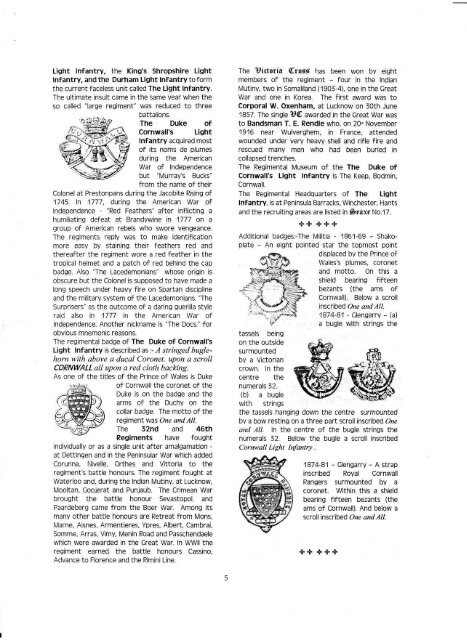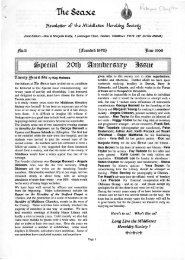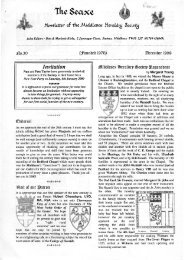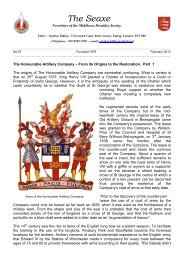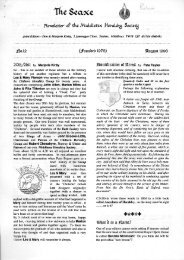The Seaxe - Middlesex Heraldry Society
The Seaxe - Middlesex Heraldry Society
The Seaxe - Middlesex Heraldry Society
Create successful ePaper yourself
Turn your PDF publications into a flip-book with our unique Google optimized e-Paper software.
Light Infantry, the King's Shropshire Light<br />
Infantry, and the Durham Light Infantry to form<br />
the current faceless unit called <strong>The</strong> Light Infantry.<br />
<strong>The</strong> ultimate insult came in the same year when the<br />
so called "large regiment" was reduced to three<br />
battalions.<br />
<strong>The</strong> Duke of<br />
Cornwall's Light<br />
Infantry acquired most<br />
of its noms de plumes<br />
during the American<br />
War of Independence<br />
but "Murray's Bucks"<br />
from the name of their<br />
Colonel at Prestonpans during the Jacobite Rising of<br />
1745. In 1777, during the American War of<br />
Independence - "Red Feathers" after inflicting a<br />
humiliating defeat at Brandywine in 1777 on a<br />
group of American rebels who swore vengeance.<br />
<strong>The</strong> regiments reply was to make identification<br />
more easy by staining their feathers red and<br />
thereafter the regiment wore a red feather in the<br />
tropical helmet and a patch of red behind the cap<br />
badge. Also "<strong>The</strong> Lacedemonians" whose origin is<br />
obscure but the Colonel is supposed to have made a<br />
long speech under heavy fire on Spartan discipline<br />
and the military system of the Lacedemonians. "<strong>The</strong><br />
Surprisers" as the outcome of a daring guerilla style<br />
raid also in 1777 in the American War of<br />
Independence. Another nickname is "<strong>The</strong> Docs." for<br />
obvious mnemonic reasons.<br />
<strong>The</strong> regimental badge of <strong>The</strong> Duke of Cornwall's<br />
Light Infantry is described as :- A stringed buglehorn<br />
with above a ducal Coronet, upon a scroll<br />
CORNWALL all upon a red cloth backing.<br />
As one of the titles of the Prince of Wales is Duke<br />
of Cornwall the coronet of the<br />
Duke is on the badge and the<br />
arms of the Duchy on the<br />
collar badge. <strong>The</strong> motto of the<br />
regiment was One and All.<br />
<strong>The</strong> 32nd and 46th<br />
Regiments have fought<br />
individually or as a single unit after amalgamation -<br />
at Dettingen and in the Peninsular War which added<br />
Corunna, Nivelle, Orthes and Vittoria to the<br />
regiment's battle honours. <strong>The</strong> regiment fought at<br />
Waterloo and, during the Indian Mutiny, at Lucknow,<br />
Mooltan, Goojerat and Punjaub. <strong>The</strong> Crimean War<br />
brought the battle honour Sevastopol, and<br />
Paardeberg came from the Boer War. Among its<br />
many other battle honours are Retreat from Mons,<br />
Marne, Aisnes, Armentieres, Ypres, Albert, Cambrai,<br />
Somme, Arras, Vimy, Menin Road and Passchendaele<br />
which were awarded in the Great War. In WWII the<br />
regiment earned the battle honours Cassino,<br />
Advance to Florence and the Rimini Line.<br />
5<br />
<strong>The</strong> Victoria Cross has been won by eight<br />
members of the regiment - four in the Indian<br />
Mutiny, two in Somaliland (1903-4), one in the Great<br />
War and one in Korea. <strong>The</strong> first award was to<br />
Corporal W. Oxenham, at Lucknow on 30th June<br />
1857. <strong>The</strong> single VC awarded in the Great War was<br />
to Bandsman T. E. Rendle who, on 20thNovember<br />
1916 near Wulverghem, in France, attended<br />
wounded under very heavy shell and rifle fire and<br />
rescued many men who had been buried in<br />
collapsed trenches.<br />
<strong>The</strong> Regimental Museum of the <strong>The</strong> Duke of<br />
Cornwall's Light Infantry is <strong>The</strong> Keep, Bodmin,<br />
Cornwall.<br />
<strong>The</strong> Regimental Headquarters of <strong>The</strong> Light<br />
Infantry, is at Peninsula Barracks, Winchester, Hants<br />
and the recruiting areas are listed in <strong>Seaxe</strong> No.17.<br />
+ + + + +<br />
Additional badges:-<strong>The</strong> Militia - 1861-69 - Shakoplate<br />
- An eight pointed star the topmost point<br />
displaced by the Prince of<br />
Wales's plumes, coronet<br />
and motto. On this a<br />
shield bearing fifteen<br />
bezants (the arms of<br />
Cornwall). Below a scroll<br />
inscribed One and All.<br />
1874-81 - Glengarry - (a)<br />
a bugle with strings the<br />
tassels being<br />
on the outside<br />
surmounted<br />
by a Victorian<br />
crown. In the<br />
centre the<br />
numerals 32.<br />
(b) a bugle<br />
with strings<br />
the tassels hanging down the centre surmounted<br />
by a bow resting on a three part scroll inscribed One<br />
and All. In the centre of the bugle strings the<br />
numerals 32. Below the bugle a scroll inscribed<br />
Cornwall Light Infantry.<br />
1874-81 - Glengarry - A strap<br />
inscribed Royal Cornwall<br />
Rangers surmounted by a<br />
coronet. Within this a shield<br />
bearing fifteen bezants (the<br />
arms of Cornwall). And below a<br />
scroll inscribed One and All.


